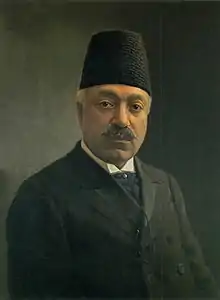Abolqasem Naser ol-Molk
Abu’l-Qāsem Khān Qarāgozlu (Persian: ابوالقاسمخان قراقزلو), known by the title Nāṣer-al-molk (Persian: ناصرالملک, lit. 'Assistant of the Realm'), (July 13, 1856 – 26 December 1927) was an Iranian politician who served as Regent, Prime and Finance Minister of Iran during the Qajar dynasty.[1]
Abolqasem Naser al-Molk | |
|---|---|
 | |
| Regent of Persia | |
| In office March 1911 – 21 July 1914 | |
| Appointed by | Parliament |
| Monarch | Ahmad Shah |
| Preceded by | Azod al-Molk |
| 5th Prime Minister of Iran | |
| In office 27 October 1907 – 21 December 1907 | |
| Monarch | Mohammad Ali Shah |
| Preceded by | Moshir al-Saltaneh |
| Succeeded by | Nezam al-Saltaneh |
| Minister of Finance | |
| In office 1904–1906 | |
| Monarch | Mozaffar ad-Din Shah |
| Prime Minister | Eyn od-Dowleh |
| In office February 1897 – June 1898 | |
| Monarch | Mozaffar ad-Din Shah |
| Prime Minister | Amin od-Dowleh |
| Vali of Kurdistan | |
| In office 1900–1904 | |
| Monarch | Mozaffar ad-Din Shah |
| Prime Minister | Amin al-Soltan |
| Personal details | |
| Born | 13 July 1856 Sheverin, Qajar Iran |
| Died | 26 December 1927 (aged 71) Tehran, Pahlavi Iran |
| Political party | Moderate Socialists Party |
| Children | 3 |
| Relatives | Hossein Ala (son-in-law) |
| Alma mater | |
| Awards | |
Early life
Al-Molk studied at the Balliol College, Oxford, from 1879 to 1882. Among his classmates were Sir Edward Grey, later British Foreign Secretary, and Cecil Spring-Rice, later British Ambassador to Tehran and Washington.
Political career
Prime Minister
After returning to Iran, he became an interpreter for Naser al-Din Shah. Later he served as Finance Minister, then as Governor, and for a short time as Prime Minister during the period of the Constitutional Revolution of Iran in the reign of Mohammed Ali Shah Qajar in 1907. However, under pressure from some parliamentarians he resigned. Because he failed to ask Mohammed Ali Shah for his permission before resigning, the latter had him arrested. Al-Molk was released from prison only after an intervention by the British ambassador. Seeing his life threatened, he fled to England.
Regent
He did not return to Iran until after the fall of Mohammed Ali Shah in the summer of 1909 where he was installed as Regent for the infant Ahmad Shah Qajar and assumed the office of prime minister once again for a short time. He held the office of Regent until Ahmad Shah came of age in 1914. In a deep political character analysis of Al-Molk, the American treasurer-general of Persia William Morgan Shuster suggested that he showed a lack of strong leadership in his office.[2]
Life in England
In 1915, Al-Molk left Iran and lived in England until his death. In 1919, he made another political appearance as an advisor to Lord Curzon in the drafting of the Anglo-Persian Agreement of August 1919. He died in 1927 at the age of 64.[3]
References
-
- Bakhash, Shaul (May 16, 2016) [December 3, 2015]. "NĀṢER-AL-MOLK, ABU'L-QĀSEM". In Yarshater, Ehsan (ed.). Encyclopædia Iranica. New York City: Bibliotheca Persica Press. Retrieved September 12, 2016.
- "The strangling of Persia; a record of European diplomacy and oriental intrigue : Shuster, William Morgan, 1877-1960 : Free Download & Streaming : Internet Archive". Internet Archive. 1912. chapter IX.
- Cyrus Ghani: Iran and the rise of Reza Shah. From Qajar collapse to Pahlavi rule. I. B. Tauris, London u. a. 1998, ISBN 1-86064-258-6.
External links
 Media related to Abolqasem Naser ol-Molk at Wikimedia Commons
Media related to Abolqasem Naser ol-Molk at Wikimedia Commons